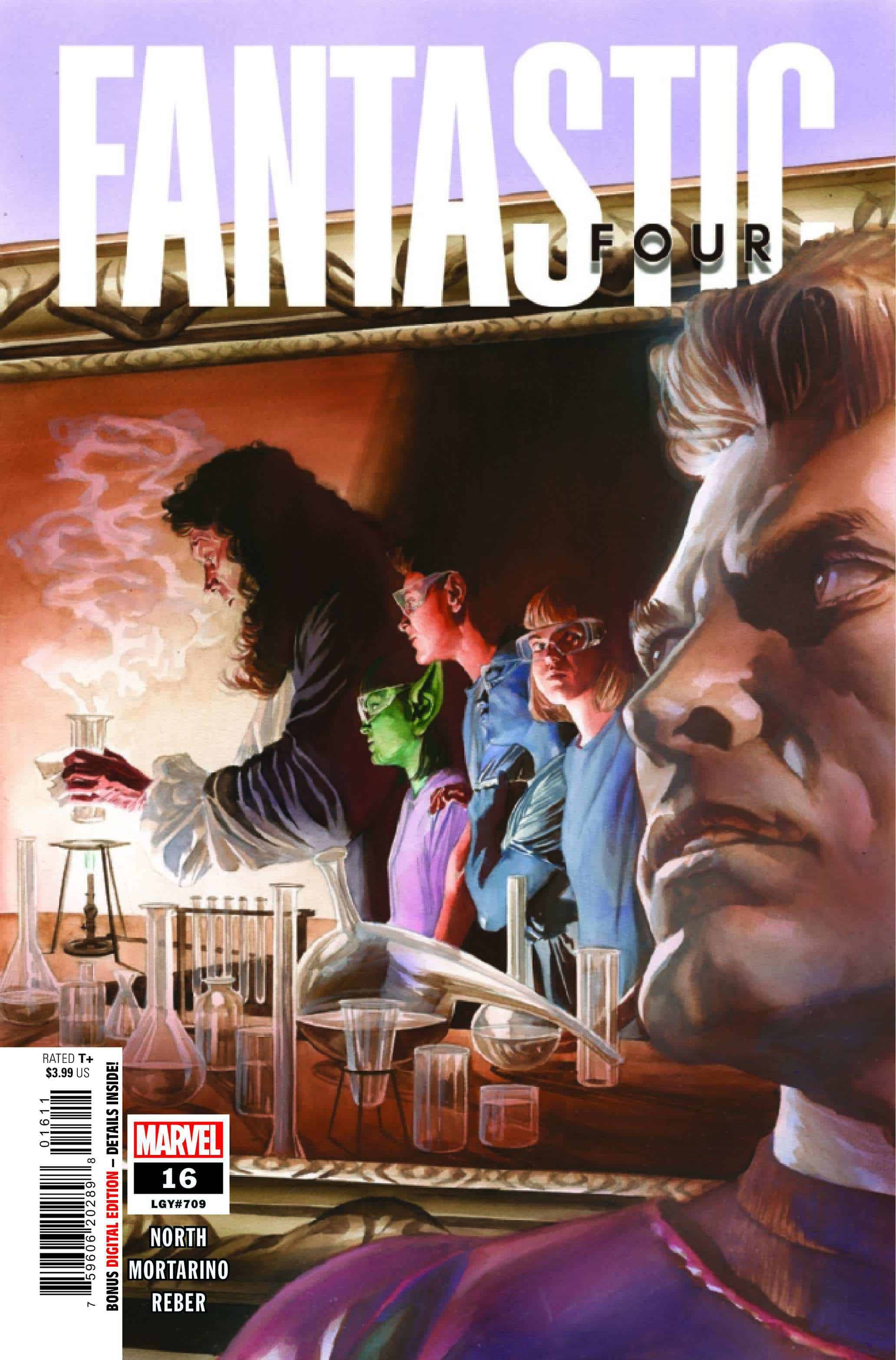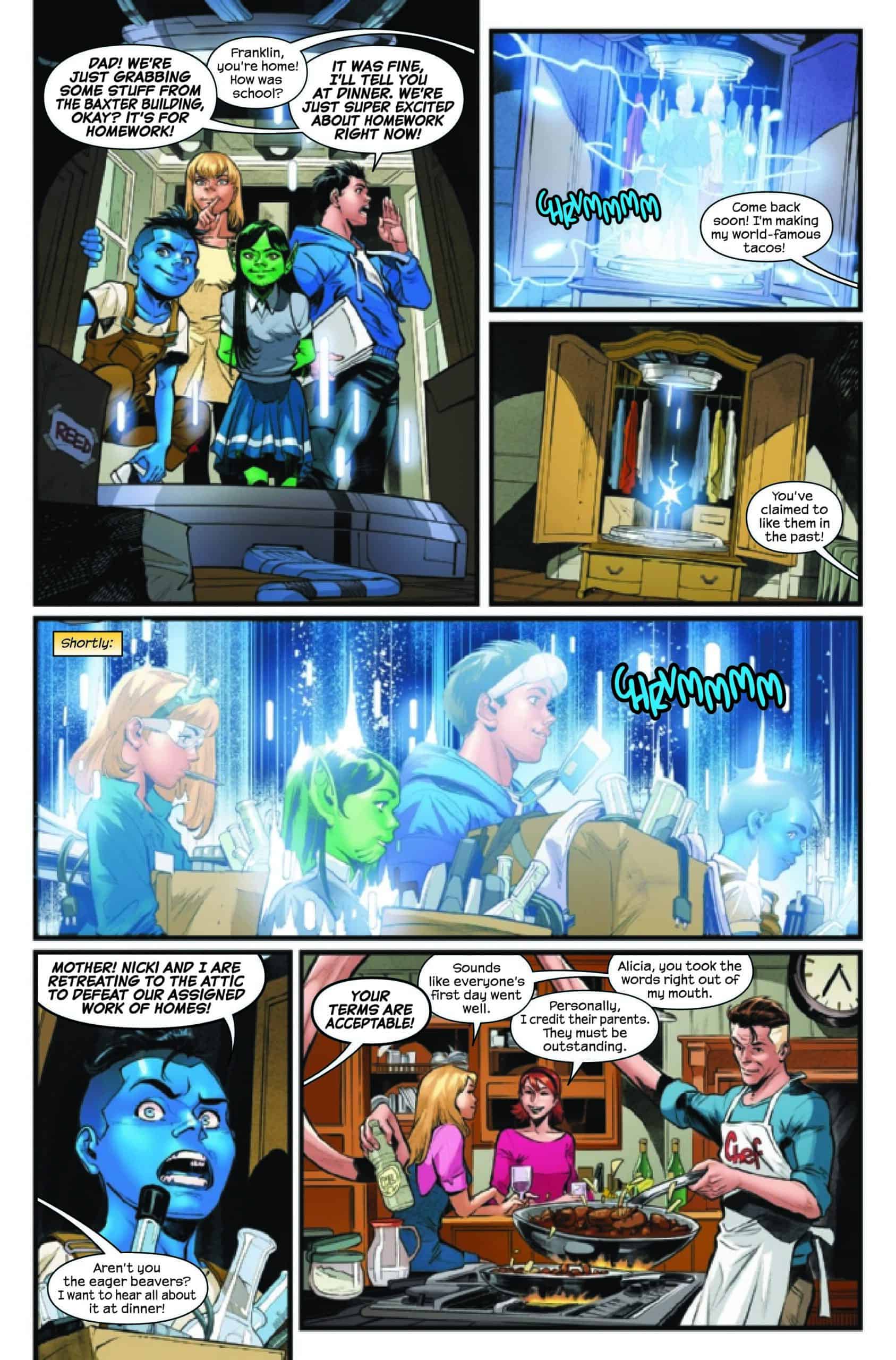Fantastic Four #16

Recap
When a teacher shares a list of inventions a scientist from the 1600s hoped future generations would one day make, Valeria and Franklin Richards decide to go for bonus points...by ticking off some of those unfinished items and inventing the impossible. Enlisting the aid of Jo-Venn and N'Kalla Grimm, the four of them engage in a little amateur mad science that quickly spirals out of hand! Do they go to their parents and ask for help? Of course not! A couple of kids can easily fix this, right? According to the couple of kids involved in this series of bad decisions: yes! Absolutely! Nothing will possibly go wrong.
Review
The time displaced Baxter Building is back, and Franklin, Valeria, Nicki, and Jo have rejoined their family who is still living in Aunt Petunia’s house in Arizona. And now that normalcy has returned, nothing can possibly go wrong. Except that in Fantastic Four #16, it absolutely does–and in very entertaining fashion.
It’s Franklin, Valeria, Nicki, and Jo’s first day at a new school in Fantastic Four #16. Franklin and Valeria’s science teacher gives the class an innocuous assignment: write about a technology that 17th century Robert Boyle predicted and detail what scientific advancements led to its development. Franklin and Valeria decide to overachieve and develop one of Boyle’s predicted technologies that hasn’t been realized yet. They transport back to the Baxter Building, grab some supplies, and create a universal solvent–something that can dissolve anything. In short order it melts through the test tube, through the house, into the ground, and toward the Earth’s core. The kids solve that problem by collecting the solvent and shooting it into the sun. Valeria realizes after the fact that that will cause even more problems. Naturally, the next option is shooting it into a black hole. And whether that works or not, they still have to write an essay.
North wisely kicks off Fantastic Four #16 with each kid getting introduced at the head of their respective class. It allows the characters to give readers a quick rundown on who they are and what they can do via meeting their new classmates. It’s very effective exposition, taking place entirely in issue rather than on a recap page and lasting only a page with a mere handful of dialogue bubbles.
A trademark of North’s Fantastic Four run is a focus on character and family. It’s therefore not surprising that the first issue following the children’s return is all about them. North takes some of the more zany sensibilities of past issues and dials them up here for an occasionally frantic adventure. The lack of an antagonist works especially well for the kids-focused issue. They get themselves into trouble, then get themselves into more trouble by trying to get out of trouble, and then finally have to go to their parents because they got into more trouble after that. And thanks to the series’ stories being so varied in tone and plot, North can deliver a kids-centric issue without it feeling silly or out of place.
The Baxter Building transporter being located in a wardrobe is a wonderful detail.
The “science lesson” in Fantastic Four #16 is a quick mention of Robert Boyle, a scientist and inventor who lived in the mid to late 17th century. He’s considered the first modern chemist. North includes a prominent display of all the technologies that Boyle hoped would be created (a very impressive list).
Fantastic Four #16 is Mortarino’s first issue, and he does a good job. The younger characters’ expressions are exaggerated at times, namely through very wide open mouths to convey excitement (whether good or bad). It’s a trait that Mortarino doesn’t use with the adults, and it serves to emphasize the children’s youth as a consequence. That visual effect is a good counterbalance to the kids’ evident genius conveyed in North’s dialogue.
Reed (like most of the adults) is absent from most of the issue, but his few appearances are quite memorable. Reed is using his power in almost every panel he appears, and always for the most mundane reason. When serving himself at dinner, he stretches his arm to reach the serving plate. When pouring a solution into a test tube, he extends his forearm to pour rather than raise his arm. When sitting at the dinner table but talking to someone who is standing up, he extends his neck. Regardless of whether this was entirely North’s idea in the script or more of a collaboration between North and Mortarino, Mortarino pulls it off perfectly. The movement isn’t flamboyant and doesn’t call attention to itself. It simply happens.
Reber’s coloring is largely effective in this issue. The issue takes place in multiple settings during different parts of the day, and as such is dealing with a variety of different light colors and sources. There are a few times when color shading doesn’t quite line up with where light seems to be coming from and the direction in which shadows are cast. But these moments are few and far between.
The kids do a lot of shouting in the issue. Caramagna gets to do everything from bold in normal font to bold in all caps to medium-large somewhat curved colored letters to large colored block letters. Fantastic Four is typically conservative when it comes to sound effects and varied fonts for dialogue, so flashier choices always stand out. And in this case, Caramagna’s work on North’s script choices further enhances the characters’ youth.
Final Thoughts
It’s hard to call Fantastic Four #16 a departure for the series. While the featured characters are not who we’ve typically seen to this point, the tone is consistent with what the series has established. Nevertheless, its lower stakes and slightly ramped up humor bring a breath of fresh air after several more urgent seeming issues.
Fantastic Four #16: The All-Kid Issue
- Writing - 9/109/10
- Storyline - 8.5/108.5/10
- Art - 8/108/10
- Color - 7.5/107.5/10
- Cover Art - 7.5/107.5/10





